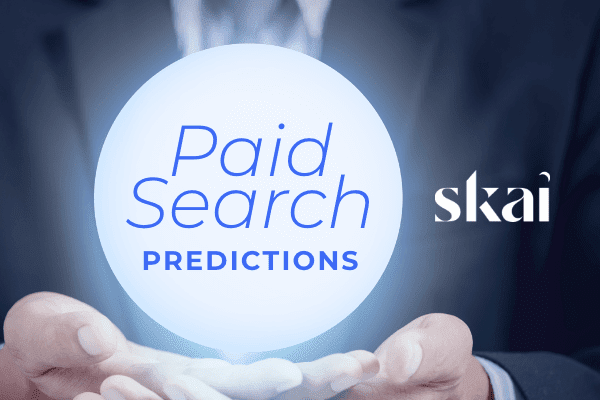
Joshua Dreller
Sr. Director, Content Marketing @ Skai

Joshua Dreller
Sr. Director, Content Marketing @ Skai

As the internet’s most mature marketing channel, one may assume that paid search doesn’t evolve as fast as other types of advertising, but that couldn’t be further from the truth. There’s so much going on with this channel, and paid search marketers will have their hands full next year just to keep up.
2024 is a landmark year for paid search, with Google’s decision to discontinue third-party cookies heralding a new era for digital advertising. This change isn’t just a tweak in the system; it’s a foundational shift happening in Q3 of 2024, placing first-party data at the forefront of advertising strategies. Advertisers must pivot quickly, harnessing their data resources to stay competitive.
Meanwhile, artificial intelligence transforms account management from a manual task into a sophisticated, data-driven process. AI isn’t just a supplementary tool; it’s becoming an indispensable ally in crafting and refining advertising campaigns.
The mantra ‘the more data, the better’ is becoming increasingly relevant. Privacy changes like Apple Mail’s tracking parameter removal are a stark reminder of the growing importance of self-collected data. The solution lies in effective tools such as Google’s global site tag and enhanced conversions in Google Ads.
All of which allow advertisers to gather detailed user information while respecting privacy, a delicate but essential balance in today’s digital world. Implementing settings like ‘Customer data terms’ and ‘Enhanced conversions for leads’ provide advertisers with advanced options to track and utilize user interactions. This strategic data collection is about staying current and setting the pace for upcoming changes.
If there’s been one major trend over the past few years that has transformed digital advertising more than anything else, it’s the rise of ecommerce brought on by the pandemic. The change in consumer behavior towards more online shopping for even the smallest household and grocery items is a shift that has pushed ecommerce ahead of schedule by 3-5 years.
So, what is the role of paid search in the new commerce funnel?
For the last two decades, paid search has been applied at all phases as marketers attempt to use it to drive awareness, consideration, and conversion on its own. However, as the digital ad industry matures, what’s becoming quickly evident is that different channels are best suited for specific parts of a full-funnel digital strategy. For example, paid search can now drive users to partners such as Amazon, Walmart, and Best Buy, where they can transact with a trusted retailer.
Search marketers will finally start working closer with their other ad channel teams and make adjustments to their programs to best complement a holistic approach rather than a siloed, paid search-only one.

There’s still plenty to do, even with automation. As more of the core tasks of the channel are handed off to intelligent machines, paid search marketers will still be as busy as ever — but in other areas. Keyword expansion, tuning our match types, testing creative, daypart analysis, applying bid modifiers, and other impactful optimizations will become the focus.
Audiences are one of the areas that paid search marketers will be able to focus on more next year due to the rise of helpful automation for many core tasks. While Google released basic audience targeting nearly ten years ago, much of the prioritization time has been spent optimizing keywords. But of course, search audiences just make a lot of sense. We 100% should be using different bids and ads for customers who search on the same keywords but are different audiences, such as returning customers, those who know about us but haven’t done business with us before, or those who have never been to our website. Users who are In-Market for our goods or services should be more prized than the average person.
It’s not that search marketers don’t know that audiences are important; they do. It’s just that the day is only so long. However, with more program elements handled by machines, audiences can become more of a priority and proper practice area for marketers. This means employing real strategy, focus, and best practices for search audiences, not just using them more.
And audiences are also becoming more critical due to the continuing growth of consumer data tracking limitations and challenges. Other channels such as display and video are becoming harder to target and measure. Search audiences offer big brands the ability to reach targetable groups with accuracy and scale — marketers just need the time to focus on them.

2021’s massive iOS14 shift in how mobile users are tracked has brought this issue further to the forefront. Today’s brands are interested in complying with external regulations and setting the bar high for whenever and wherever they engage with online consumers. As a result, we have received more requests from our clients about protecting their users to better understand and steward their data practices both within and outside their walls.
We see this as a very positive trend that will continue. A safer digital experience should pave the way for even more online consumer spending and benefit every company that does business via the web.
As more brands and web publishers tighten up their data practices, search marketers are beginning to fully realize that their first-party data can be used as a competitive edge. Whether it’s applied to audiences, auto-bidding, or dynamic creative, the less viable data from third-party sources means that their first-party data will become more valuable.
In a sense, each brand is shoring up its walls and becoming “walled gardens” themselves. We’ve been seeing this evolution over the last handful of years, as brands understand that if every company uses Google’s targeting options, it’s too even of a playing field. First-party data changes the game. A great example of this is Skai’s Signal Enhancement, which enables search marketers to get their first-party data into Google Search Ads to let Smart Bidding optimize their campaigns using the best data signals. For example, an education client might want to optimize via custom metrics or a blend of conversions using custom weighting. This can only be done using their unique first-party.
We expect first-party data to grow in importance with search marketers.

On the other hand, testing approaches — such as incrementality testing — are tried and true. Using the framework outlined in the Scientific Method we learned about in middle school, marketers can run studies using Test and Control groups to get precise measurement results for optimizing media. Testing methodologies such as Media Mix Modeling (MMM) have been used for decades but can be slow, complex, and expensive. However, with AI and machine learning innovations, incrementality testing is now faster, easier, and more affordable than ever before.
The paid search predictions shared in this article are the evolution of trends that have been growing for some time. Are you ready in these areas? If not, we can help.
Skai has been a leader in enterprise technology, serving marketers since 2006 with paid search as one of our flagship platforms. Our history of innovation in data, bidding, and measurement, combined with an independent, media-agnostic, and omnichannel position, sets search marketers up to stay in control while driving true business growth — at scale.
Drive smarter investment decisions with solutions that handle recurring tasks and deliver insights and intelligence to take your paid search programs to the next level.
Start the year off right. It takes less than a minute to sign up for a brief demo to see everything Skai has to offer. Benchmark your current tech solution against the innovative features of Skai’s Paid Search platform.
You are currently viewing a placeholder content from Instagram. To access the actual content, click the button below. Please note that doing so will share data with third-party providers.
More InformationYou are currently viewing a placeholder content from Wistia. To access the actual content, click the button below. Please note that doing so will share data with third-party providers.
More InformationYou are currently viewing a placeholder content from X. To access the actual content, click the button below. Please note that doing so will share data with third-party providers.
More Information